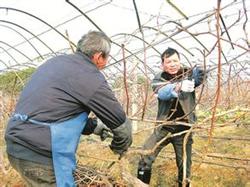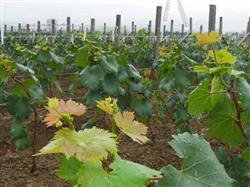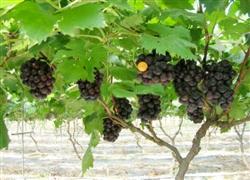Winter pruning technique of grapes in scaffolding

Most of the scaffolding grapes are trimmed by the "keel" method, which can maintain good ventilation and light transmission, strengthen the top advantage, make the tree strong, and achieve the goal of high quality and stable yield. First, it is more appropriate to use a single slope scaffolding for the retention and shearing of the main vine, which is inclined to the south. Munag grape grows vigorously. According to its characteristics of high temperature and sunlight, the tilt angle is 25-40 degrees, the height of the front frame is about 1.2 meters, the height of the rear frame is about 2 meters, the row spacing is about 6 meters, the plant spacing is 1.5-2 meters, the width of the frame is 4-5 meters, each plant leaves 3-4 main vines, and 50-70 seedlings are used for every 667 square meters. the grapes are exposed to sunlight at a good angle and have a relatively large area, which is conducive to photosynthesis and ventilation. It is also conducive to mechanized operations such as weeding, fertilization and soil loosening, so that the main vines are evenly distributed on the shelf surface. Second, the pruning and retention of fruiting mother branches directly affect the quality and yield of grapes. Large retention, large plant load, dense branches and leaves, poor light ventilation, small fruit, poor quality; less retention affects yield. The number of remaining plants is determined according to the character and growth of the plant. generally, a fruiting branch group is left on the first wire of the main vine every 25 cm, and 1-2 fruiting mother branches are left in each group. When pruning in winter, the height of the main vine should be strictly controlled below the first wire, thin, weak and diseased branches should be cut off, including cross branches, and the front and back balance of the main vine should be maintained in order to form the maximum resulting area. 3. The pruning length of the fruiting mother branch results the pruning of the mother branch can be divided into long and short shoots, with 2-4 nodes in short shoot pruning, 6 nodes in middle shoot pruning and 10 nodes in long shoot pruning. The remaining length is determined according to character, branch thickness maturity, pruning form, fertilizer and water conditions and management level. Generally, the seed setting rate of 4-7 nodes is higher, but the seed setting rate of later nodes is poor, so the pruning method of medium and long shoots can be adopted. All the sprouting branches on the main vine below the grape shelf are cut off to ventilate in the shelf. due to the sun exposure, the grapes on the main vine under the shelf are dark and rusty, with ugly skin thickness, high tannin content and astringent taste, affecting the overall quality of the grapes. Fourth, the fruiting part is removed from the reserve branch and the fruiting mother branch to form a fixed branch group. for the bald phenomenon of the main vine, a strong branch tip can be selected in advance from the sprouting leaves of the root as the reserve vine for short cutting, and 4-8 segments can be left for short cutting according to the thickness of the branches. In the following year, after the long fruiting mother branch completes the fruiting task, it can be thinned, while the 2-3 new shoots issued on the reserve branch and the lower ones are still pruned according to the middle and long shoots, leaving them as fruiting mother branches. There are still 2-3 shoots in the lower position, which can be used as reserve branches. If the shoots are pruned according to this method in the third year, the fruit-bearing parts of the fixed branches can be moved outward.
- Prev

Field management needs to be strengthened after grape harvest.
As the tree is weak after grape harvest, the field management should be strengthened to improve the cold resistance of the plant in winter and promote the growth of new branches in the following year. Pruning Qingyuan on the basis of summer pruning continues to do a good job of heart-picking and branching, removing tendrils and thin branches, and removing diseased leaves, so as to reduce nutrient consumption and promote full bud eyes. At the same time, remove weeds from the garden.
- Next

Early Fruit cultivation techniques of American Black and Red Grape
First, the garden construction technology: 1. Garden selection: grape is most suitable for sandy loam with loose soil and rich organic matter. two。 Frame type selection: in order to produce early and increase the previous yield, we should choose the hedge type, mainly the single hedge type. Row spacing 2-2.5 m, frame height 2-2.5 m, pillar spacing 4-5 m, in the pillar.
Related
- Moge, come on! The staff of the peasant association in the producing area of cantaloupe were frightened when the crowd gathered.
- Causes and Solutions of low Fruit setting rate of Apple
- Symptoms and control measures of passion fruit virus disease
- Fruit growing lesson: how do apple orchards keep high yields?
- Can you build orchards in the mountains? What are the pros and cons?
- How to manage the coloring period of Crisson grape?
- This paper introduces the processing technology of two kinds of fig products.
- How much is a month for retired teachers in rural areas by 2020?
- How can strawberry planting increase sugar content? We should pay attention to management in many aspects.
- What are the cultivation techniques on how to improve the yield of golden fruit?

